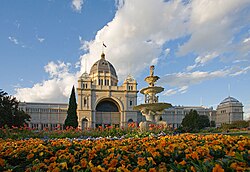It received restoration throughout the 1990s and in 2004 became the first building in Australia to be awarded UNESCO World Heritage status, being one of the last remaining major 19th century exhibition buildings in the world. It sits adjacent to the Melbourne Museum and is the largest item in Museum Victoria's collection. Today, the building hosts various exhibitions and other events and is closely tied with events at the Melbourne Museum.

1980s–present
During a visit to Victoria in 1984, Princess Alexandra (Queen Elizabeth II's cousin) bestowed the royal title on the building and it has been referred to as the Royal Exhibition Building ever since. This title, and the first conservation assessment of the building undertaken by Alan Willingham, sparked a restoration of the interiors of the building in the late 1980s and 1990s, and the construction of a mirror glass annexe (which was later demolished). In 1996, the then Premier of Victoria, Jeff Kennett, proposed the location and construction of Melbourne's State Museum on the adjacent site. Temporary annexes built in the 1960s were removed and in 1997 and 1998, the exterior of the building was progressively restored.The location of the Melbourne Museum close to the Exhibition Building site was strongly opposed by the Victorian State Labor Party, the Melbourne City Council and the local community. It was as a result of the community campaign opposing the museum development that John Brumby, then State opposition leader, with the support of the Melbourne City Council, proposed the nomination of the Royal Exhibition Building for world heritage listing. The world heritage nomination did not progress until the election of the Victorian State Labor Party as the new government in 1999.
On 1 July 2004, the Royal Exhibition Building and Carlton Gardens was granted listing as a World Heritage Site, the first building in Australia to be granted this status. The heritage listing states that "The Royal Exhibition Building is the only major extant nineteenth century exhibition building in Australia. It is one of the few major nineteenth century exhibition buildings to survive worldwide."
In October 2009, Museum Victoria embarked upon a major project to restore the former German Garden of the Western Forecourt. The area had been covered by asphalt in the 1950s for car parking.
Current use
The Royal Exhibition Building is still in use as a commercial exhibition venue, hosting many events on a regular basis such as the Melbourne International Flower and Garden Show. Regular tours are also offered by Melbourne Museum.The Royal Exhibition Building is used as an exam hall for the University of Melbourne, Royal Melbourne Institute of Technology, Melbourne High School, Nossal High School and Mac.Robertson Girls' High School
However, it is no longer Melbourne's largest commercial exhibition centre. The modern alternative to the Royal Exhibition Building is the Melbourne Exhibition and Convention Centre, located in Southbank to the south of the central city area.



No comments:
Post a Comment